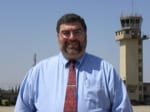By SCOTT MALTA, For General Aviation News
“Scott, this is your official notification that we’ve had a pilot deviation.”
As airport manager, I’ve heard these dreaded words from the air traffic manager of the control tower at Castle Airport in Merced, Calif., too many times. In fact, since opening the control tower in December 2006, we’ve had 15 pilot deviations — and that’s 15 too many.

After some investigation, I discovered the root cause of all these deviations: It’s “us,” the pilots.
Common errors seen in all of the pilot deviations include poor preflight planning or poor pilot performance once airborne.
Sometimes it’s mystifying how these errors are made.
For example, Castle Airport (MER) sits seven miles away from the Merced Municipal Airport (MCE). Castle’s runway is 11,802 feet compared to Merced’s 5,903 feet, yet we have had several pilots enter the pattern and land on our runway thinking they were at Merced.
It’s usually after the pilot reads, “CASTLE AIRPORT ~ ELEVATION 188 FEET” on the side of the control tower that they realize their mistake.
How did these pilots miss all the clues, like Castle’s really long runway, or that Castle’s runway is 31/13 and Merced’s is 30/12, or that all of Castle’s ramps and services are to the west of the runway and Merced’s are to the east, or the fact that none of the other five airplanes in the pattern were responding to their radio calls or, for that matter, speaking on the radio at all?
In the pilots’ defense, we understand that at an uncontrolled airport, such as MCE, radio calls, while recommended, are not mandatory. But isn’t it a little strange that none of the other five airplanes in the pattern were making any radio calls?
Some pilots never call Flight Service Stations for weather and NOTAM briefs. Others fail to dial up the AWOS or ASOS where local airport information may be presented.
Several years ago, two aircraft entered the pattern and landed on the main runway — right in the middle of a construction zone. They had not gotten any NOTAM information and were not aware the runway was closed. They flew directly over the lighted and flashing “X” on the numbers and narrowly missed several large yellow pieces of construction equipment that were on the runway.
As I was writing this article, I was called by the tower and given that dreaded message again: “Scott, this is your official notification that we’ve had another pilot deviation.”
The tower manager told me of a pilot who had just landed in a closed portion of our parallel taxiway undergoing repairs. Thankfully, the contractor was working just off the taxiway at the time. The pilot had not flown for some time (but did have another, current pilot with him). They had not gotten a weather or NOTAM brief, they clearly hadn’t reviewed flight information regarding Castle Airport, and completely missed the 150-foot-wide runway with big white threshold markings, centerline, edge lines, numbers and touchdown zone markings, Precision Approach Path Indicator (PAPI) lights, landing instead on the 100-foot-wide taxiway that is prominently marked with bold yellow centerline and double edge stripe markings.
I also had the opportunity to host a nice young couple while they waited for the FBI and Secret Service to arrive and interview them. It seems they flew into a Temporary Flight Restriction (TFR) zone surrounding the President’s arrival a little north of my airport. They were intercepted by two armed F-16s — one alongside of them (after twice flying across the young pilot’s nose) and the other lined up behind them. They were ordered to land at Castle and wait for the authorities to arrive. Exciting though this was, it could have been avoided had the pilot filed a VFR flight plan and gotten a weather and NOTAM brief from Flight Service.
Then, there were the pilots who were flying with outdated charts and publications. None of them were aware that Castle has had an operating control tower since 2006 and that it is surrounded by Class D airspace. One pilot had Sectional Charts dated 2000 and 2001 when he landed unannounced at Castle in 2007. Another pilot entered “MER” into his GPS, thinking he was entering Merced Municipal Airport and flew direct to Castle Airport and landed there. If the pilot had a current database in his GPS, the message light should have been flashing to warn him of his approach to the Special Use Air — the Castle Class D. Perhaps he just missed it.
Pilots have landed on the runway opposite to the direction of the rest of the traffic — something I bet you only thought happened in the movies.
Another pilot entered the standard pattern for MCE, believing that he was at that airport. Unfortunately, he was at Castle. As he was flying a low-wing airplane, he didn’t notice the Cessna below his altitude on final as he turned base, then final, and actually landed directly over the top of the landed and rolling-out Cessna. The instructor pilot in the Cessna figured the distance between his aircraft and the one above him to be less than 20 feet — a disaster only narrowly averted.
As pilots, we cannot allow ourselves any slack when it comes to preparing for flight or while we are flying. When I was an Air Force instructor boom operator on KC-135 Stratotankers, we had a saying when it came to regulations and publications: “It’s either by the book or buy the farm.”
Let’s do ourselves and fellow pilots a favor: Take those few extra minutes before flying to follow the recommendations in the FAR and AIM. Be fully aware of where we’re going and that we are going to the correct airport; and follow proper radio, approach and departure discipline to ensure we all arrive alive.
